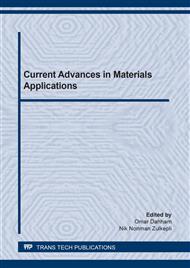p.140
p.151
p.161
p.175
p.187
p.200
p.211
p.221
p.230
Study the Effect of the Heat Treatment on the Photoelectrochemical Performance of Binary Heterostructured Photoanode Ag2S/ ZnO Nanorod Arrays in Photoelectrochemical Cells
Abstract:
Heterostructured semiconductors are considered one of the most significant candidates for photoelectrochemical cells (PECs) water splitting because of their visible photovoltaic features. Hence, this study displayed the synthesis of Ag2S NPs/ZnO nanorods arrays (NRAs) as a function of annealing temperature in the range between 100 °C and 500 °C. The heterostructured photoanode was fabricated through two- simple steps synthesis; the first one was hydrothermal method (HT) and the second one successive ionic layer adsorption and reaction (SILAR) method. Structural morphology characteristics, chemical conformation and properties of synthesized nanostructure were studied via different characterization techniques such as field emission scanning electron microscopy (FE-SEM), X-ray diffraction spectroscopy (XRD), HR-TEM and EDX, correspondingly. The XRD results showed that the hexagonal phase of ZnO NRAs combined successfully with monoclinicAg2S nanoparticles. The optical properties throughout absorbance spectra disclosed that with increasing the annealing temperature, the absorbance edges shifted toward extended wavelength indicating considerable enhancement in the optical properties upon the heat -treatment. Additionally, Ag2S nanoparticles/ZnO NRAs was employed as a working photoanode in photoelectrochemical cell consists of three-electrodes configuration. The result showed an important improvement in the performance of photoelectrochemical cell. It was observed that Ag2S/ZnO NRAs upon annealing at 400 °C showed an impressive photocurrent density, photoconversion efficiency of 2.73 mA/cm2 and 2.33%, respectively by achieving ~8 times higher compared to ZnO NRAs (0.337 mA/cm2). Such this enhancement was attributed to the morphological structure improvement, crystallinity and optical properties enhancement of the heterostructured photoanode after the conducting annealing process.
Info:
Periodical:
Pages:
187-199
Citation:
Online since:
July 2020
Price:
Сopyright:
© 2020 Trans Tech Publications Ltd. All Rights Reserved
Share:
Citation:


